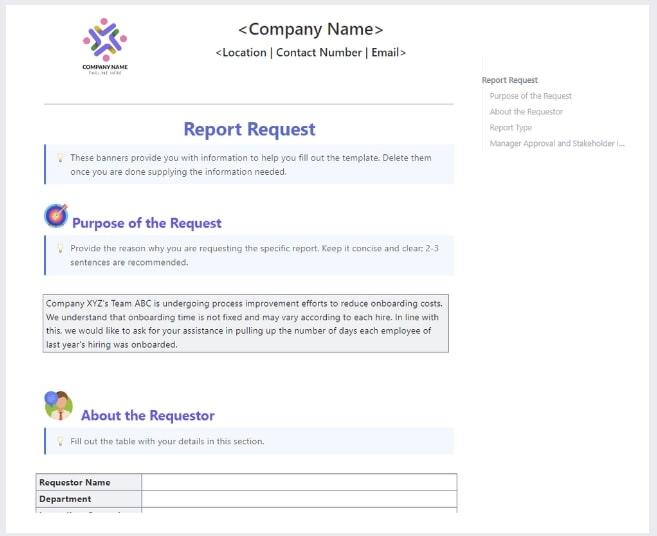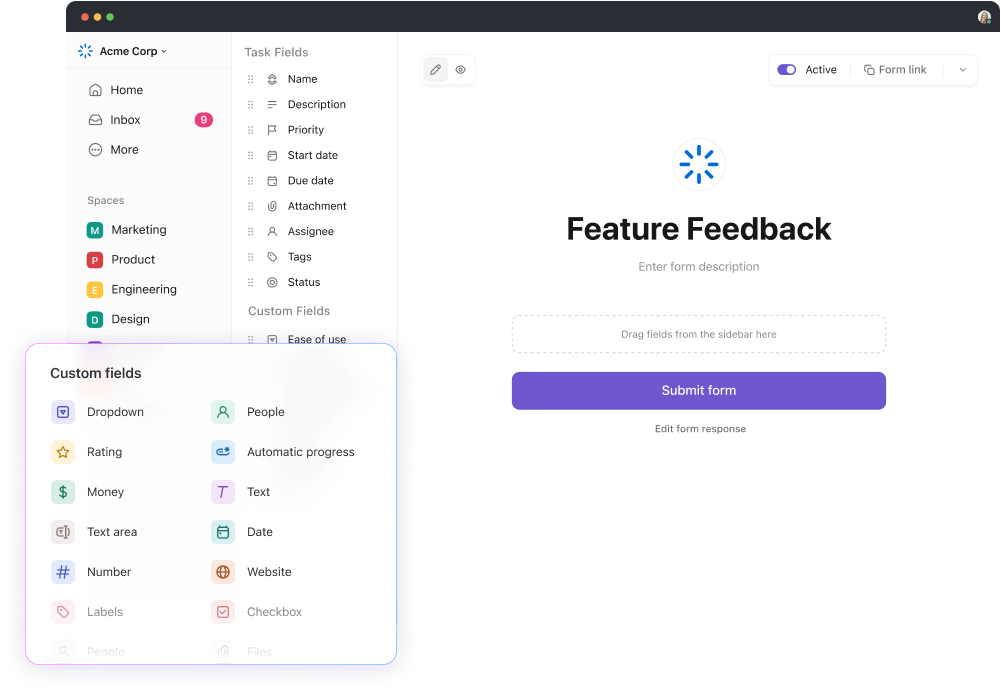بصفتك مدير مشروع، يجب عليك تقدير وإدارة العديد من المتغيرات التي ينطوي عليها المشروع. ويتضمن ذلك تحديد متطلبات العمل بحيث يمكن ترجمتها إلى مهام محددة للمشروع.
وتحدد متطلبات المشروع المعيار "الأدنى" الذي يجب أن يحققه المنتج لحل مشاكل المستخدم النهائي بفعالية. المتطلبات التي تتعلق بالميزات والجوانب التقنية للمشروع - ميزات ووظائف وقدرات المنتج النهائي - تسمى المتطلبات التقنية في مصطلحات إدارة المشروع .
في هذا الدليل الشامل للمتطلبات الفنية في إدارة المشاريع، سنغطي الأنواع المختلفة من المتطلبات الفنية التي قد تواجهها، وكيفية جمعها وإدارتها بكفاءة.
ما هي المتطلبات الفنية؟
في إدارة المشاريع، المتطلبات الفنية هي المخطط الذي يحدد الوظائف والميزات والجوانب الفنية التي يجب أن يستوفيها المشروع.
وتشمل هذه المتطلبات أيضاً أي قيود تقنية يجب التغلب عليها لإنجاز المشروع بنجاح.
ومن منظور المنتج البرمجي، فإن المتطلبات الفنية متطلبات المشروع تشير إلى كيفية بناء المنتج. وبالتالي، ستغطي هذه المتطلبات جوانب الأجهزة والبرمجيات والأداء والموثوقية والأمان.
لنفترض أنك تريد بناء أداة مؤسسية تعمل عن بُعد تسمح لفريقك بالعمل من المنزل.
تشمل الاعتبارات الرئيسية التي ستحتاج إلى التفكير فيها كيفية المصادقة على المستخدمين، وكيف سيتم تزويدهم بإمكانية الوصول إلى البيانات، ونوع ميزات الاتصال التي يجب أن تتوفر لديهم (خدمات مثل الدردشة ورسائل البريد الإلكتروني ومؤتمرات الفيديو، وما إلى ذلك)، وما إلى ذلك.
ستركز متطلباتك التقنية على ضمان التواصل السلس والتعاون وإمكانية الوصول وتلبية متطلباتك الأمنية.
 قالب متطلبات النظام الجاهز للاستخدام من _ClickUp
هو نعمة لمشاريع تطوير البرمجيات
قالب متطلبات النظام الجاهز للاستخدام من _ClickUp
هو نعمة لمشاريع تطوير البرمجيات
ستشكل المتطلبات والميزات التالية الأساس التقني لهذا المشروع:
- التوافق مع الأجهزة (أجهزة الكمبيوتر المحمولة والمكتبية والهواتف المحمولة وغيرها) وأنظمة التشغيل
- متطلبات البرامج والأجهزة
- لغة برمجة لاستخدامها
- شبكة خاصة افتراضية (VPN) للوصول الآمن إلى شبكة الشركة ومواردها
- قدرات متعددة اللغات لبرمجة البرامج
- أنظمة التخزين وإدارة المستندات المستندة إلى السحابة
- بروتوكولات التشفير والمصادقة متعددة العوامل (MFA) للأمان
- اتصال إنترنت عالي السرعة لدعم مؤتمرات الفيديو ومشاركة الملفات وما إلى ذلك
- برنامج سطح المكتب البعيد لدعم تكنولوجيا المعلومات لاستكشاف المشكلات وإصلاحها على أجهزة الموظفين
- الامتثال للوائح حماية البيانات، مثل اللائحة العامة لحماية البيانات، وقانون حماية البيانات العامة (GDPR)، وقانون حماية البيانات العامة (CCPA)، إلخ.
قد يختلف مصدر المتطلبات التقنية، بما في ذلك الإرشادات التنظيمية، واتجاهات السوق الحالية، وما إلى ذلك.
تتناول المتطلبات الفنية أسئلة أساسية في عملية إدارة المشروع، مثل:
- كيف سيلبي المنتج احتياجات المستخدم النهائي وتوقعاته؟
- كيف سيتوافق المنتج مع المعايير الفنية المعتمدة؟
- ما الذي سيختبره المستخدمون النهائيون عند تفاعلهم مع المنتج؟
- ما نوع الموارد التقنية التي ستساعد في تحقيق طلبات المستخدم النهائي؟
- كيف سيتم دمج المنتج مع الأنظمة والبنية التحتية الحالية؟
- ما هي متطلبات الأداء وقابلية التوسع؟
- ما هي التدابير الأمنية التي ستساعد في حماية موارد النظام وبياناته؟
- كيف سيتعامل المنتج مع الأخطاء والاستثناءات والحالات الطارئة؟
- هل هناك أي متطلبات امتثال ومتطلبات تنظيمية يجب الوفاء بها؟
- ما هي متطلبات الصيانة والدعم؟
- كيف سيتم اختبار المنتج للتأكد من أنه يلبي المتطلبات الفنية المحددة؟
- ما هي متطلبات النشر والتنفيذ للمنتج؟
لا يوجد متطلبان تقنيان متشابهان في جدول المتطلبات التقنية - كل ذلك يعتمد على المنتج والأهداف النهائية للمشروع.
أهمية المتطلبات الفنية في إدارة المشروع 71% من المشاريع إما تفشل تمامًا أو تواجه "تحديات" - والسبب الرئيسي هو أنها لا تقدم الميزات والوظائف التي يتوقعها العميل.
إنشاء مشروع متعمق ميثاق المشروع هي إحدى الطرق التي يمكن اتباعها.
ومع ذلك، بالنسبة لمنتجات البرمجيات، فإن جدول المتطلبات الفنية يعزز التفاهم المتبادل بين فرقك والعملاء بحيث يعرف الجميع ما يمكن توقعه.
كما أنه يضمن ألا تعيق المشاكل التقنية ومواطن الخلل تقدم المشروع.
التركيز على متطلباتك التقنية تخطيط إدارة المتطلبات خطوة ذكية لأنها
### يجلب نهجًا منظمًا لتخطيط المشروع
يمكن أن تصبح المتطلبات في المشاريع المعقدة متعددة الطبقات. تساعد وثيقة المواصفات الفنية على إنشاء قائمة الأولويات من المهام الفرعية وتعامل كل مهمة فرعية كمشروع أصغر. وهذا يحقق المزيد من الكفاءة والوضوح والتنظيم لعملية تخطيط المشروع
### يمنع زحف النطاق
تدعيم نطاق المشروع المتعلقة بميزات المنتج ووظائفه في وقت مبكر يمكن أن يوفر على الفريق الكثير من الجهد والوقت. تسلط وثيقة المتطلبات الفنية الضوء على جميع ميزات المنتج المطلوبة من وجهة نظر تقنية
تستخدم كنقطة مرجعية لاستخدام الموارد التقنية
تسلط وثيقة المواصفات الفنية القابلة للمشاركة الضوء على حجم ونوع الموارد التقنية التي سيتم استخدامها. وهذا يجعل من السهل على مديري المشروع تقدير التكاليف والالتزام بالميزانية
يجعل الفرق في "وضع التركيز"
التأخيرات غير المتوقعة، وعدم توفر الموارد، وتغير توقعات العميل، وما إلى ذلك، تعيق زخم الفريق. يساعد وجود مستند سهل الاستخدام الفريق على التركيز على المنتج النهائي المطلوب مع الحفاظ على جميع الميزات والوظائف المتوقعة سليمة
دفع عملية اتخاذ القرارات المستنيرة
مع وجود رؤى موثوقة حول كيفية أداء منتجك، يصبح تخصيص التكاليف والموارد والبنية التحتية وما إلى ذلك أمرًا سهلاً للغاية
يتيح اختبار المستخدم بسلاسة
يجب أن تخضع كل ميزة من ميزات منتجك لاختبارات المستخدم الصارمة للتأكد من أنها ترقى إلى مستوى توقعات العميل، وتضمن وثيقة المواصفات الفنية عدم تفويت أي شيء في مرحلة الاختبار
## أنواع مختلفة من المتطلبات الفنية

بدء المشاريع بسرعة مع *[قالب متطلبات إدارة مشروع ClickUp لإدارة المشاريع](https://clickup.com/templates/project-management-requirements-t-200549854)* تختلف المتطلبات الفنية بناءً على طبيعة المنتج الذي يتم تطويره.
الأنواع المختلفة للمتطلبات الفنية
المتطلبات الوظيفية
تحدد هذه المتطلبات ما يجب أن يحققه المنتج لاستكمال سلوك مستخدم معين. وهي تسلط الضوء على الوظائف التي يجب أن يؤديها المنتج باستخدام حالات الاستخدام، وقصص المستخدمين، وما إلى ذلك.
المتطلبات غير الوظيفية
تحدد هذه المتطلبات المعايير الرئيسية مثل الأداء والأمان والموثوقية وسهولة الاستخدام وما إلى ذلك، للحكم على أداء المنتج
متطلبات النظام
تحدد هذه المتطلبات المواصفات الفنية التي يجب أن يتمتع بها المنتج لتلبية احتياجات مستخدميه وتشمل متطلبات الأجهزة ومتطلبات البرمجيات وما إلى ذلك
متطلبات المستخدم
تسرد هذه قائمة بما يحتاجه المستخدمون من المنتج والأوصاف المقابلة للميزات المحددة المطلوبة
متطلبات العمل
تمثل هذه المتطلبات الأهداف عالية المستوى التي يجب أن يحققها المنتج لتلبية احتياجات المؤسسة وتبرير الاستثمار.
متطلبات الواجهة
تحدد هذه المتطلبات كيفية تفاعل المنتج مع الأنظمة والمكونات الموجودة، والتي تغطي متطلبات واجهات برمجة التطبيقات وتنسيقات البيانات وبروتوكولات الاتصال وما إلى ذلك
المتطلبات القانونية ومتطلبات الامتثال
هذه هي المتطلبات الأساسية للامتثال للقوانين واللوائح التنظيمية ومعايير الصناعة ذات الصلة بخصوص خصوصية البيانات والأمان وإمكانية الوصول، إلخ.
هناك طريقة أخرى للتمييز بين الجوانب المختلفة للمتطلبات الفنية.
نظرة عامة على أنواع المتطلبات التقنية العشرة التي يجب أخذها في الاعتبار عند تطوير البرمجيات
- التوافر: يشير إلى "الوقت" الذي يتعين على المستخدمين النهائيين/الفرق التفاعل مع البرنامج واستخدامه؛ ويتم التعبير عنه كنسبة مئوية ويتم تعريفه بمقياس "وقت التشغيل". كلما اقتربت من 100%، كان ذلك أفضل
- الموثوقية: يشير إلى متوسط الوقت الذي يعمل فيه البرنامج دون عطل، فكلما كان الوقت أطول، كلما كان البرنامج أكثر موثوقية. قد تعرف أيضًا هذا المقياس باسم MTBF (متوسط الوقت بين الأعطال)
- جودة البيانات: يشير إلى مدى قابلية استخدام البيانات وجودتها العالية
- أمن المعلومات: يضمن أن مشاركة البيانات آمنة وحماية البيانات الحساسة بأي ثمن
- الأداء: يشير إلى وقت تحميل المنتج
- إمكانية الوصول: يضمن توفر المعلومات المهمة للجميع في جميع الأوقات وبأقل جهد ممكن
- إمكانية الصيانة: يصف مدى سرعة العلامة التجارية في حل المشكلات الفنية - يتم قياسها بمقياس MTTR (متوسط الوقت اللازم للإصلاح)، والرقم السحري هو أقل من 60 دقيقة
- توافر الخدمة: يشير إلى السرعة التي تقوم بها الفرق بإجراء ترقيات وتغييرات وما إلى ذلك على البرنامج دون انقطاع الاستخدام
- الخطأ البشري: يعني أن البرنامج أو المنتج يجب أن يكون قادراً على تحديد متى يرتكب المستخدم خطأً وإبلاغه.
بصرف النظر عن نوع المتطلبات التقنية التي تحتاج إلى جمعها، اتبع عملية محددة للحصول على المتطلبات الصحيحة (المزيد حول هذا الموضوع أدناه).
كيفية جمع المتطلبات التقنية في إدارة المشاريع؟
جمع المتطلبات الفنية عملية مباشرة وخطية. لقد قمنا بتقسيمها إلى خمس خطوات بسيطة من أجلك.
الخطوة 1: جمع المدخلات من جميع المصادر ذات الصلة
أثناء جمع المدخلات، تأكد من أنك لا تغفل أي صاحب مصلحة مهم أو مجموعة مهمة من المستخدمين. وفي الوقت نفسه، لا تأخذ المدخلات إلا من المصادر ذات الصلة التي لديها فهم وخبرة بالمنتج. نصائح يجب اتباعها:
- استشر الأشخاص الذين يتفاعلون مع المنتج بشكل مباشر، مثل المستخدمين النهائيين والعملاء وأصحاب المصلحة ومديري المنتجات والمطورين وغيرهم.
- إنشاء استبيانات مخصصة وإجراء مقابلات شخصية حول "الحد الأدنى من التوقعات" من المنتج
- قم بإعداد اجتماع داخلي مع الفريق للتحقق من صحة قائمة المتطلبات التقنية التي تم جمعها
الخطوة 2: الانخراط في تحليل الاستخدام
يتطلب منك تحديد متطلبات أداء منتجك الخروج من منطقة الراحة الخاصة بك.
ويشمل ذلك إجراء استبيانات مع أصحاب المصلحة الخارجيين، والتشاور مع الخبراء الميدانيين، والتحدث إلى عملائك بأي وسيلة ممكنة.
نصائح يجب اتباعها:
- إجراء أبحاث السوق لفهم الاتجاهات المستمرة
- تحديد سمات المستخدمين النهائيين لفهم أنماط سلوكهم بشكل أفضل
اجمع النتائج لمعرفة مدى جودة أداء منتجك وتحقيق رضا العملاء.
الخطوة 3: إنشاء حالات استخدام والتركيز على النماذج الأولية
بمجرد أن يكون لديك إطار عمل معياري في مكانه، فقد حان الوقت لتبدأ في إنشاء نموذج أولي.
نصائح يجب اتباعها:
- أنشئ مجموعة من حالات الاستخدام المتنوعة لاختبار إطار العمل الخاص بك
- قم بإجراء تفاعلات مباشرة مع المستخدم لفهم ما يعمل وما لا يعمل
- كتابة تقرير متعمق، بما في ذلك مخططات الحالة
الخطوة 4: تضمين الصفات التقنية
تحديد مكونات الأجهزة والبرمجيات أمر مهم.
وتشمل المعلمات القياسية التي يجب قياسها كمياً الأداء وقابلية التوسع وتوافر الموارد وزمن انتقال النظام والأمان وغير ذلك.
استمر في إجراء المراجعات والاجتماعات مع الفريق لتحديد السمات التقنية المطلوبة.
على سبيل المثال، قد تتضمن المتطلبات الفنية لتطوير تطبيق ما وقت التشغيل واستجابة التطبيق وبروتوكول الأمان وسهولة الاستخدام وتكرار النسخ الاحتياطي وقابلية التوسع والصيانة وما إلى ذلك.
الخطوة 5: التحقق من صحة وثيقة المتطلبات الفنية
بعد الانتهاء من العمل التأسيسي، يمكنك إنشاء وثيقة المتطلبات الفنية.
يجب عليك تبرير كل المتطلبات الوظيفية والتقنية التي تضعها على الورق.
للقيام بذلك، قم بتضمين العناصر التالية واجعلها مضمونة:
- المستخدمون النهائيون الذين تم تعيينهم لقابلية استخدام المنتج
- المعالم الرئيسية والمواعيد النهائية المقابلة
- هيكل الفريق، إلى جانب المهارات والكفاءات المطلوبة
- دورة حياةتطوير المشروع عملية تطوير المشروع، بما في ذلك نطاق المشروع والتخطيط وإدارة التغيير والموارد وسير العمل وخطط الطوارئ
- تفاصيل المنتج، من البحث الأولي إلى الميزات المحددة في تخطيط المشروع
- البروتوكولات والنتائج المقابلة التي يتوقعها العملاء
- متطلبات النظام وتخفيف المخاطر التدابير
- الاعتبارات الخارجية مثل البيئة واللوائح وما إلى ذلك.
- المواصفات مثل الحجم، والوزن، والطول، واللون، والشكل، وما إلى ذلك، في حالة السلع المادية وأنظمة التشغيل، والواجهة، وما إلى ذلك، في حالة المنتجات الرقمية
نصائح يجب اتباعها:
- التعاون مع أعضاء الفريق والعملاء وأصحاب المصلحة الآخرين للحصول على مدخلاتهم
- التشاور مع المديرين التنفيذيين وفريق القيادة للحصول على موافقتهم النهائية
اكتب متطلبات تقنية دقيقة ومفصلة باستخدام ClickUp

قم بتسجيل متطلبات المشروع دون إغفال التفاصيل المهمة باستخدام
قالب متطلبات تقرير النقر فوق قالب المتطلبات_
أثناء التخطيط لمشروع ما، يحتاج مديرو المشاريع إلى تقييم عوامل متعددة للتأكد من أن خطة المشروع النهائية تلبي جميع احتياجات العمل والاحتياجات التقنية. اعتمادًا على نوع المشروع، يمكن أن تصل المتطلبات الفنية فقط إلى عشرات النقاط.
لست بحاجة إلى تدوين ملاحظات غزيرة للبقاء على اطلاع على هذه النقاط - فقط استخدم قوالب الوثائق الفنية في ClickUp.
ClickUp هي أداة قوية أداة قوية لإدارة المشاريع تتيح لك التحكم الكامل، مما يتيح لك جمع المتطلبات الفنية وإدارتها بنقرة زر واحدة.
فيما يلي عرض للميزات المفيدة التي تقدمها ClickUp لإدارة متطلباتك الفنية:
عرض نموذج ClickUp لإدارة الاستبيانات في الوقت الفعلي

طريقة عرض النموذج مع الحقول المخصصة
ماذا تفعل إذا كنت ترغب في إجراء مقابلة في اللحظة الأخيرة مع الرئيس التنفيذي للترويج لمنتجك الجديد في مجلة رقمية مشهورة، ولكن الوقت ضيق؟
استخدم النماذج لتمكين الرئيس التنفيذي من الإجابة عن الأسئلة في الوقت الذي يناسبه ويناسبه
استفد من عرض نموذج ClickUp لإجراء الاستطلاعات والمقابلات واستطلاعات الرأي وغيرها مع أصحاب المصلحة والمديرين والمطورين وغيرهم.
تُعدّ نماذج ClickUp واحدة من أكثر الميزات التي نطلبها، فهي تحتوي على منطق مشروط، مما يسمح لك بإنشاء نماذج ذكية وديناميكية للحصول على تعليقات المنتجات، والتعامل مع الطلبات الإبداعية، وتوجيه العملاء المحتملين للمبيعات، وغير ذلك.

كيف يعمل المنطق الشرطي في نماذج ClickUp
لن يفوتك أبدًا الحصول على معلومات حساسة للوقت وتعليقات المستخدمين المهمة.
تسمح لك هذه الوظيفة بـ
- تسجيل الردود وتوجيه العمل إلى الفريق المناسب في الوقت المناسب على الفور
- تحويل الردود إلى مهام قابلة للتتبع وتوصيلها مباشرةً بسير عملك لاتخاذ إجراءات فورية
- تخصيص الأسئلة والتقاط المعلومات ذات الصلة
إليك كيف تتكيف نماذج ClickUp مع سيناريوهات الحياة اليومية:
- السماح للمستخدمين بإرسال طلبات الميزات، أو الإبلاغ عن الأخطاء، أو اقتراح تحسينات على تجربة المستخدم، مع تحويل ردودهم إلى مهام قابلة للتتبع في سير عمل فريقك المتراكم للمنتج

نموذج ملاحظات المنتج في ClickUp
- قيادة نماذج تلقي تكنولوجيا المعلومات للإبلاغ عن الحوادث، وإدارة التغيير، وطلبات المعدات، والمزيد
- إنشاء نماذج مخصصة يتم تحديثها في الوقت الفعلي بناءً على احتياجات العميل للحصول على تجربة مخصصة للغاية
مستندات ClickUp Docs والذكاء الاصطناعي لتحليل جودة البيانات واستخراج الرؤى
على الرغم من أن جمع ملاحظات العملاء أمر رائع، إلا أن المعلومات لا طائل من ورائها إذا لم تتمكن من توليد رؤى منها واستخدامها لتحسين الأداء.
أدخل مستندات ClickUp و انقر فوق الذكاء الاصطناعي .
ClickUp Docs رائعة لإنشاء - وتحرير - مستند المتطلبات الفنية في الوقت الفعلي مع فريقك. ضع علامة على الآخرين بالتعليقات، وقم بتعيين عناصر الإجراءات، وتحويل النص إلى مهام قابلة للتتبع.

التعليقات المعينة في ClickUp
إنشاء مواصفات فنية شاملة تحدد بوضوح نطاق المشروع وأهدافه.
توثيق وتوصيل متطلبات المنتج مثل الميزات الضرورية والوظائف الهامة وتجربة المستخدم المتوقعة.
تحويل الأهداف والمتطلبات إلى مهام ومهام فرعية، وتتبعها في مكان واحد.

مثال على مستند متطلبات المنتج في ClickUp
لتحسين الدقة والسرعة، يمكنك إنشاء مستندات المتطلبات الفنية باستخدام ClickUp AI، الذي يقدم أكثر من 100 مطالبة نموذجية كاملة مصممة خصيصًا لتلبية احتياجاتك. فيما يلي مثال على قالب صفحة غلاف التقرير الفني ClickUp جاهز للاستخدام.

_قالب قالب صفحة غلاف التقرير الفني _ClickUp
إحدى أدوات الذكاء الاصطناعي الشهيرة القائمة على الأدوار في ClickUp هي مولد مستند المواصفات الفنية الذي يساعد في إنشاء مستندات المواصفات الفنية، وتحليل بيانات العملاء بحثًا عن عوامل مثل ملفات تعريف المستخدم النهائي وأنماط السلوك وما إلى ذلك، وتبسيط العمليات وتحسين الإنتاجية.
توفير الوقت الثمين الذي كان يمكن إنفاقه على تنسيق وهيكلة وثيقة المتطلبات الفنية. أضف المعلومات الضرورية (فكر في: اعتبارات التصميم وتفاصيل التنفيذ والمزيد) ودع المولد يتولى الأمر!
صياغة المتطلبات التقنية بوضوح لسد الفجوة في الوظائف والأداء
لا ينبغي التعامل مع المتطلبات التقنية كفكرة ثانوية - فهي مهمة لمشروعك مثل أهمية الملكة في لعبة الشطرنج!
المتطلبات الفنية هي أوصاف محددة للمواصفات الفنية للمشروع، بما في ذلك متطلبات الأجهزة والبرمجيات، ومعايير الترميز، ومعايير الأداء توحيد العملية وإجراءات الاختبار، إلخ.
يتم صياغتها بشكل واضح ومفصّل، وهي توجه المشروع نحو النجاح.
ومع ذلك، فإن السمة الحقيقية لوثيقة المتطلبات الفنية الجديرة بالاهتمام هي أن تكون مرئية وصحيحة من الناحية الواقعية ومصاغة بشكل تعاوني وسهلة الفهم.
إن أداة إدارة المشروع مثل ClickUp تفي بجميع حسابات الإدارة الفنية وتخطيط المشروع - بدءًا من تحديد المتطلبات الفنية لمشروعك إلى إدارة توقعات العملاء ومعالجة كل ما بينهما. قم بالتسجيل مجاناً اليوم!

